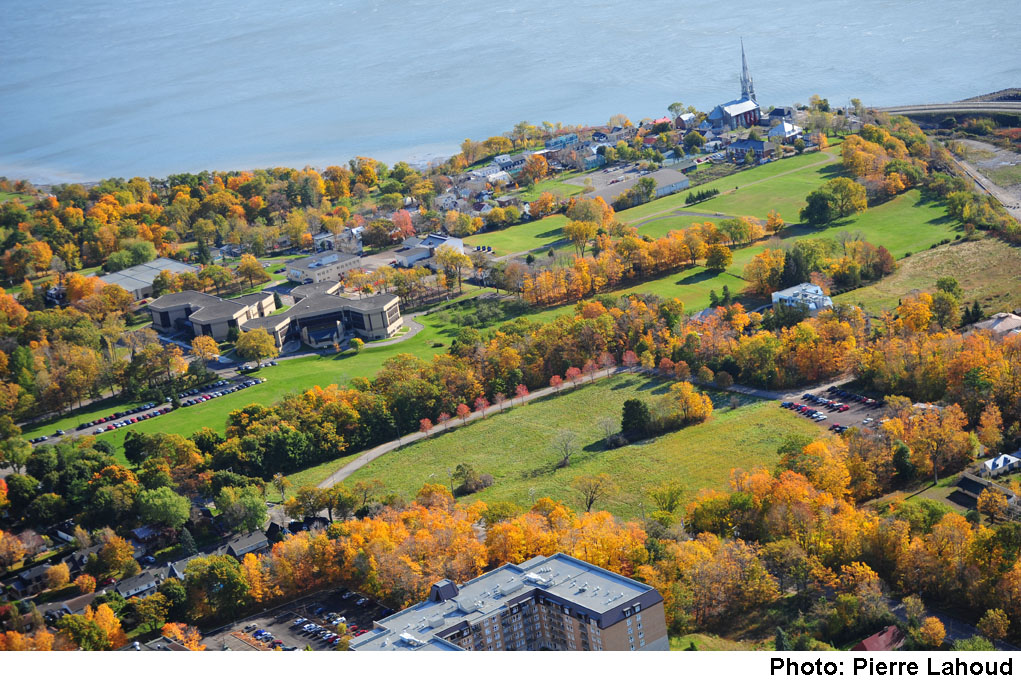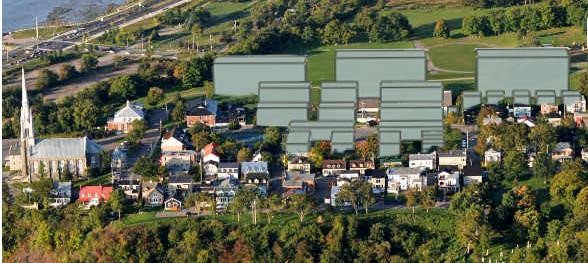
Sillery District
 News Alert: On June 2, the National Trust's letter to Mayor Labeaume urging respect for the integrity of les Grands Domaines is read aloud at the public consultation meeting attended by over 600 residents. The range of recommendations from the public resulted in the City postponing the adoption of the PPU until the fall, allowing time for possible revisions.
News Alert: On June 2, the National Trust's letter to Mayor Labeaume urging respect for the integrity of les Grands Domaines is read aloud at the public consultation meeting attended by over 600 residents. The range of recommendations from the public resulted in the City postponing the adoption of the PPU until the fall, allowing time for possible revisions.
Historic District of Sillery – Quebec, Quebec—FUTURE OF HISTORIC DISTRICT UNCERTAIN DESPITE 1964 PROVINCIAL DESIGNATION
As early as 1964, the province of Quebec made the visionary choice to protect an extraordinary cultural landscape characterized by large traditional estates with expansive greenspace. Now, with condominium developers circling, advocates are pressing officials to uphold the law and ensure appropriate development of the Historic District of Sillery.
Why it matters
The Historic District covers a linear 3.5 kilometre wide territory along the St. Lawrence River dominated by adjacent grand estates integrated into a picturesque natural environment. The area bears witness to successive occupation (the French Regime; 19th century lumber barons; and later religious communities and institutions) and has been called a cradle of the Quebec nation. Today, property lines survive from all three periods of occupation, and buildings, woodlands, viewscapes and greenspaces continue to reflect the scale and character of the original great estates.
When development threatened the integrity of the area in the 1950s, Quebec’s Ministry of Culture responded by creating the Historic District of Sillery in 1964—a visionary act designed to prevent the grand estates from sub-division and inappropriate development. Collectively, the grand estates offer enormous potential for recreation, education, tourism and carefully planned new development.
 Why it’s endangered
Why it’s endangered
In recent years, rumours of impending developments have caused increasing alarm. In Fall 2010, historic district designation notwithstanding, the City and the Minister of Culture allowed the subdivision of the Saint-Patrick Cemetery property (part of the Historic District’s Woodfield Estate) where it is feared a luxury condominium development may destroy trees dating from the French regime. Several other estates within the district are in question, as religious communities consider their options. The Mayor of Quebec has signalled his willingness to allow further subdivision and sale.
Volunteers from the natural and cultural heritage sectors have joined forces in preparation to re-fight a battle won in 1964, when similar pressures were terminated by legal protection. All agree the site warrants a high level of scrutiny and care to ensure that any changes respect historic viewscapes, landforms and character.
Where things stand
 |
| Modelling of potential impact on the landscape. |
Advocates for a conservation-minded development strategy have done much to raise public awareness, and have requested a moratorium on further development or subdivision until concerns have been addressed and a sustainable plan is in place. There is support for a recent Management Plan published by the Ministry of Culture, and a desire to see provincial protection enforced. All parties anxiously await a Plan Particulier d’Urbanisme—a detailed urban plan specific to the area in question—being developed by the City of Quebec, and promised this fall.
A petition was created in June, 2012 calling on the mayor to end the destruction of the historic district and to work on the development of a sustainable plan for the area.
UPDATE: In February, 2015, the Minister of Culture and Communications gave her preliminary approval to the City of Quebec’s PPU, which will see 800 new housing units constructed over 8 percent of the district’s area. The City hopes to encourage developers to purchase and restore heritage buildings formerly owned by religious communities in exchange for allowing development on the surrounding lands. The City argues that new development is necessary in order to attract the investment needed to preserve the district.
Foregoing public consultation, the Minister has already given the green light to the Sous-les-Bois residential development that will occupy a part of the lands belonging to the Collège Jésus-Marie and to the Benmore District. The project, whose original plan proposed the construction 300 condo units, was previously blocked by her predecessor. A spokesperson commenting on the minister’s decision indicated that the developer had come back with modifications that conformed to the province’s conservation plan for the district.
In light of the minister’s decision, the City announced that it would begin the public consultation process on its PPU this spring. Council is expected to vote on its adoption at the end of June.
Top 10 Endangered Places
- Explore Past Listings
- National
- British Columbia
- Alberta
- Saskatchewan
- Manitoba
- Ontario
- Quebec
- Bens
- Cap-des-Rosier Lighthouse National Historic Site
- Cathédrale Saint-Germain
- Estate of the Pères de Sainte-Croix
- Franciscan
- Grenville Canal
- Louis Hippolyte
- Québec - Redpath Mansion
- Saint-Vincent-de-Paul Penitentiary
- Southwest
- Très-Saint-Nom-de-Jésus
- Ville Marie
- Wallingford-Back Mine
- Winter Street Prison
- Wright Scott
- Sillery District
- Hôpital de la Miséricorde
- The Quebec Bridge
- New Brunswick
- Nova Scotia
- Prince Edward Island
- Newfoundland and Labrador
- Territories
- Worst Losses Archive
- Nominate a Site
